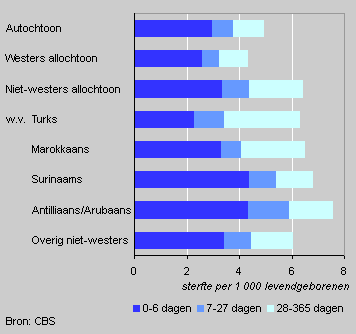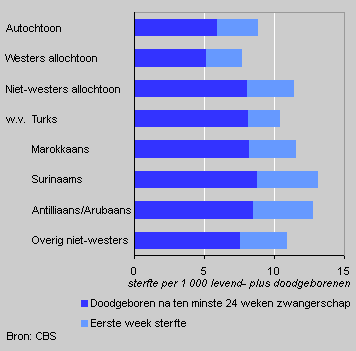Foreign babies have higher mortality risk

From 1997 to 2002, 1.2 million babies were born in the Netherlands. In this period just over 7.5 thousand children (6.2 per thousand) were stillborn in the 25th week of pregnancy or later according to figures from Statistics Netherlands. This is the equivalent of just over 1,200 babies per year. Just over 20 percent of these stillborn babies had a non-western background. This percentage is higher than the percentage of live born babies with a non-western background: 16 percent.
In the same period, 1997-2002, another 3,6 thousand children died in the first week following the birth.
Perinatal mortality by babies’ ethnic background, 1997-2002

Perinatal mortality
Babies with one or two non-western foreign parents are more likely to die before birth or shortly after birth than babies of two native Dutch parents. This perinatal mortality was 11.4 per thousand births in the period 1997-2002 for all non-western foreign groups together. This mortality rate is nearly 30 percent higher than that for babies of native Dutch parents (8.9 per thousand births). The risk of stillbirth is nearly 40 percent higher among all non-western groups together than among native Dutch babies.
The differences in the mortality rates are nearly all caused by differences in mortality in the first seven days following the birth. These mortality rates are least favourable for Surinamese and Antillean/Aruban babies. Their risk of dying within a week of being born is significantly higher than that for Turkish babies. There are only very small differences between the various non-western groups in the risks of stillbirth, however.
Infant mortality by babies’ ethnic background, 1997-2002

Infant mortality
The situation with respect to infant mortality, too, is less favourable for non-western foreign babies than for Dutch babies: on average they have a 30 percent greater risk of dying.
Again the highest mortality rates are for babies with at least one parent from Suriname or the Antilles/Aruba. They have a 40 to 50 percent greater chance of dying before their first birthday.
Relatively speaking the greatest differences in infant mortality are after the first four weeks. In this period the mortality risk of Turkish and Moroccan children are highest, over twice as high as for Dutch babies.
Various factors are at play here. Marriages with relatives, for example, which are more common among Turks and Moroccans, increase the risk of babies inheriting certain genetic conditions. And teenage pregnancies, which carry a higher risk of premature birth and low birth weight. There is a higher risk of infant mortality if the teenage mother is not in a stable relationship, a situation that is relatively common among girls with an Antillean/Aruban or Surinamese background.
Joop Garssen and Anouschka van der Meulen